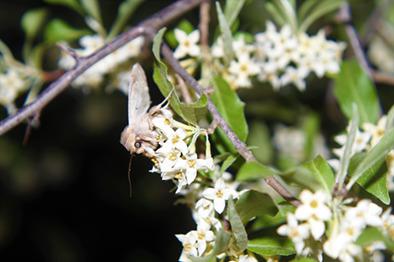当前位置:
X-MOL 学术
›
Plant Species Biol.
›
论文详情
Our official English website, www.x-mol.net, welcomes your
feedback! (Note: you will need to create a separate account there.)
Reproductive biology and pollinators of the invasive shrub Autumn olive (Elaeagnus umbellata Thunberg)
Plant Species Biology ( IF 1.1 ) Pub Date : 2020-11-17 , DOI: 10.1111/1442-1984.12307 Nathan M. Soley 1, 2 , Sedonia D. Sipes 1
Plant Species Biology ( IF 1.1 ) Pub Date : 2020-11-17 , DOI: 10.1111/1442-1984.12307 Nathan M. Soley 1, 2 , Sedonia D. Sipes 1
Affiliation

|
This study examined the reproductive biology of the invasive nitrogen‐fixing shrub Elaeagnus umbellata. Hand‐pollination experiments and pollinator‐exclusion experiments were performed in four Illinois, U.S.A. populations to determine the breeding system of E. umbellata, and floral visitors were collected to determine pollinators in the invasive range. Although self‐compatibility is a trait shown to confer invasiveness, our experiments revealed that E. umbellata is a mostly outcrossing species with a self‐incompatible breeding system. Variation does exist in that a small percentage of individuals allow self‐fertilization through autogamy. There is also variability among plants in the separation of male and female floral parts that may further affect selfing potential. The majority of floral visitors to E. umbellata were generalist pollinators, including bees, flies, and moths. Many of the larger insect visitors are pollinators of E. umbellata based on analysis of pollen on insect specimens, but smaller insects do not pollinate as frequently. Its ability to attract generalist pollinators means that E. umbellata will produce fruit wherever pollinators and mates occur; however, the low fruit set on open‐pollinated branches contrasts with the idea of a prolifically fruiting plant. E. umbellata seems to serve as a reliable food source for many ecologically and economically significant insects, including native bumble bees (Bombus), the exotic honey bee (Apis mellifera), and armyworm (Mythimna unipuncta), a crop pest.
中文翻译:

侵入性灌木秋季橄榄(Elaeagnus umbellata Thunberg)的生殖生物学和传粉媒介
这项研究检查了入侵固氮灌木Elaeagnus umbellata的生殖生物学。在美国伊利诺伊州的四个种群中进行了人工授粉实验和传粉媒介排除实验,以确定伞形大肠杆菌的繁殖系统,并收集了来访者以确定入侵范围内的传粉媒介。尽管自相容性是赋予侵袭性的特质,但我们的实验表明,伞形大肠杆菌(E. umbellata)是具有自交不亲和育种系统的大部分异种。确实存在差异,因为只有一小部分人允许通过自动配偶进行自我受精。雄花和雌花部分的分离在植物间也存在差异,这可能进一步影响自交潜力。伞形花草的大多数花卉访客都是通花授粉者,包括蜜蜂,苍蝇和飞蛾。根据昆虫标本上的花粉分析,许多较大的昆虫来访者都是伞形花粉的传粉者,但较小的昆虫却不那么频繁地授粉。它具有吸引普通传粉媒介的能力,这意味着E. umbellata在授粉媒介和配偶发生的任何地方都会结出果实;但是,在开放授粉的树枝上结实程度低的果实与多产果树的想法形成了鲜明对比。E. umbellata似乎是许多具有生态和经济意义的昆虫的可靠食物来源,包括本地大黄蜂(Bombus),外来蜜蜂(Apis mellifera)和粘虫(Mythimna unipuncta)。
更新日期:2020-11-17
中文翻译:

侵入性灌木秋季橄榄(Elaeagnus umbellata Thunberg)的生殖生物学和传粉媒介
这项研究检查了入侵固氮灌木Elaeagnus umbellata的生殖生物学。在美国伊利诺伊州的四个种群中进行了人工授粉实验和传粉媒介排除实验,以确定伞形大肠杆菌的繁殖系统,并收集了来访者以确定入侵范围内的传粉媒介。尽管自相容性是赋予侵袭性的特质,但我们的实验表明,伞形大肠杆菌(E. umbellata)是具有自交不亲和育种系统的大部分异种。确实存在差异,因为只有一小部分人允许通过自动配偶进行自我受精。雄花和雌花部分的分离在植物间也存在差异,这可能进一步影响自交潜力。伞形花草的大多数花卉访客都是通花授粉者,包括蜜蜂,苍蝇和飞蛾。根据昆虫标本上的花粉分析,许多较大的昆虫来访者都是伞形花粉的传粉者,但较小的昆虫却不那么频繁地授粉。它具有吸引普通传粉媒介的能力,这意味着E. umbellata在授粉媒介和配偶发生的任何地方都会结出果实;但是,在开放授粉的树枝上结实程度低的果实与多产果树的想法形成了鲜明对比。E. umbellata似乎是许多具有生态和经济意义的昆虫的可靠食物来源,包括本地大黄蜂(Bombus),外来蜜蜂(Apis mellifera)和粘虫(Mythimna unipuncta)。









































 京公网安备 11010802027423号
京公网安备 11010802027423号